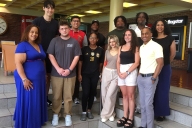You have /5 articles left.
Sign up for a free account or log in.
This past weekend I went bowling, and I lost. 3 games to nil. My opponent - a 13 year old middle-schooler.
If you haven't been bowling lately you may have missed some big changes. Gutter balls no longer exist. Instead, our bowling alley gives the option of having bumpers on the side. Not only is scoring automatic, (no more keeping score by hand on paper), it is almost impossible to miss the pins.
My 13 year old opponent could not bowl as fast as I can. What she can do, and what I was not able to achieve, is purposely using the bumpers. She bowled with bank shots. Anyone who has played basketball knows that shots off the backboard have a higher chance of going in. Same with bowling, as banking off the bumper delivers the ball to the pins at an angle that tends to knock more pins down.
The problem I had was that I could not bring myself to use the bumper. Bowling into the gutter felt wrong, almost like cheating. So I kept trying to roll the ball faster and faster, and I kept getting beat.
You probably see where I'm going with this. When my 13 year old ends up in college, she will have all sorts of study and learning advantages that I did not have in 1987. Lectures will be recorded for review (and hopefully preview). Assessments will be formative, not just summative, so she will be able to practice with the material ahead of exams and diagnose where she needs to concentrate her studying.
Materials that I once spent hours gathering and photocopying at the library will all be available instantly on her laptop, tablet or mobile phone. By 2017, when she starts college, the long-dreamed-of PLE (personal learning environment) should be a reality. Her PLE will assess her competencies - and then deliver curriculum, assessments, and community (through social components) that will assist in studying. Powerful analytical packages will track her progress through each class, and provide her (and her institution) early warning signs for possible academic problems, even suggesting steps for remediation.
Us more senior educators, (over 30?), tend to view higher education through our own experiences as students. We had to work to get our materials, had to attend class and take notes, and didn't have the option of surfing Facebook during a lecture. We didn't have bumpers. But perhaps today's students are playing a different game. Just maybe all the digital tools, platforms and communities are resulting in a different kind of learning than we experienced. A learning more appropriate to the 21st century workforce, where nobody pays anyone a professional salary for knowing as much as a Google search.
We could always force our students back to our college experience, we could remove the bumpers, but are we sure that we'd be providing a better (and more relevant) educational experience?
Anyone want to go bowling?








